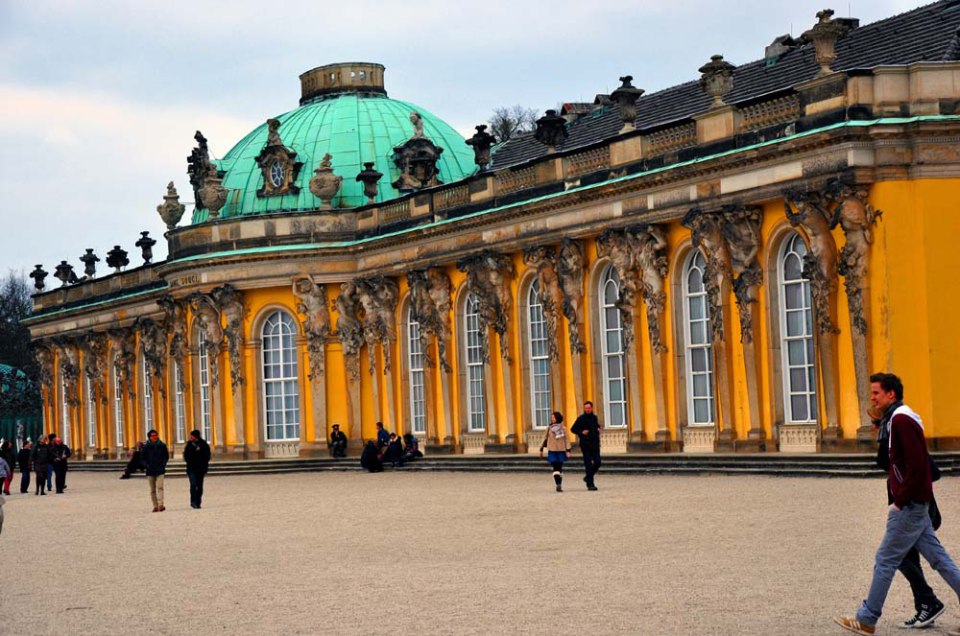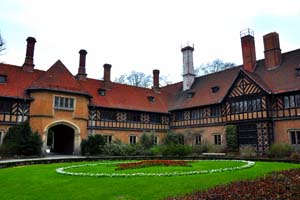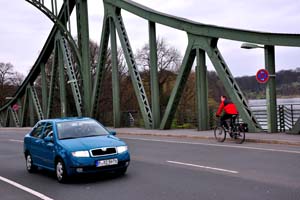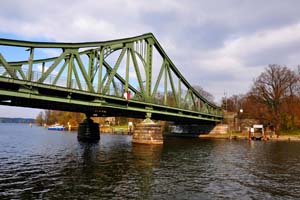I grip the handlebars of my bike and glide onto the bridge, braking in the middle where a red-and-white striped barber pole of a barricade separated the East from the West during the Cold War. My imagination conjures up big-coated agents of the KGB and the CIA staring each other down as they swapped spies, the men stepping gingerly from the grip of their enemies.
Then a shiny red Audi honks as it rushes past, startling me back to the present. I take one last look at Glienicke Bridge, painted a dirty, Kermit the Frog green, and pedal back to the city center.
Lying 15 miles southwest of Berlin, Potsdam barely resembles the gray, oppressive place it was before the Berlin Wall came down. Der Spiegel calls it “The German Beverly Hills” in a nod to its burgeoning film industry and wealthy residents.
I find plenty of sights worth seeing in this former Prussian capital, but difficult to get to on foot because they are scattered across the city’s ample green spaces and along the network of waterways that surrounds it. With a bike, though, no problem.
Plenty of Potsdamers take to two wheels to travel about, using dedicated bike lanes and pedestrian streets, such as the Brandenburger Strasse with its swanky shops and sidewalk cafes. I rent a bike from my hotel, Grossen Waisenhaus, and set off to join them.
Following my fascination with the Cold War, I pedal through the “Forbidden City,” a neighborhood of upper middle class homes seized by the Soviets and walled off from outsiders until 1994. Vladimir Putin served in the KGB headquarters here. Who knows what went on inside the thundercloud gray prison next door where unfortunates waited to die or be sent to Siberia.
Historians say the Cold War began nearby at Cecilienhof palace on what was then Joseph Stalin’s turf. “Uncle Joe” sat down with Harry Truman and Winston Churchill to hammer out new boundaries for post-World War II Europe. Near the end of the Potsdam Conference, Truman received the telegram: “The baby is born” telling him the atomic bomb was ready. From a modest office set up for him here, he gave the order to drop “the baby” on Japan.
The last royal palace built in Germany, Cecilienhof was the residence of Crown Prince Wilhelm who lived there until March, 1945 when he and his family fled in advance of the Red Army. Completed in 1917 in English Tudor style of peach stucco and mossy-brown half timbers, its design makes it appear smaller than its 176 rooms. With World War I on—and Germans starving—the Kaiser thought it best to conceal its opulence.
The residence overlooks Holy Lake, but when the Wall went up on the lawn, the only view was of ugly gray concrete and barbed wire. I mount up and ride along a lakefront path where border guards once walked on patrol. It takes me perhaps 15 minutes pedaling leisurely to reach Potsdam’s most famous royal palace, Sanssouci.
Prussia’s King Frederick the Great hated women, so when he built his summer palace, meaning “free from care” in French, he banned them. Not even his wife was allowed inside. His father forced him to marry, but as soon as he died Frederick sent her away, calling her “my old cow.” I look inside and it’s obvious women were not welcome; the seats of the rose-petal pink brocade sofas are far too narrow to accommodate 18th-century skirts.
Built according to Frederick’s own sketches, the palace showcases Prussian rococo. Frederick gathered his best buddies in the Marble Hall for lunches lasting five or six hours. Voltaire was a regular. They discussed philosophy, music and poetry, made fun of religion and told vicious jokes about women.
My tour guide speculates that Frederick’s feelings about females stemmed from his horrible childhood. His father, King Frederick Wilhelm I, despised him because he hated hunting, was afraid of guns, didn’t like beer and preferred to spend his time playing his flute. His father beat him in public, called him “a woman” and when he and a friend were caught trying to escape to England his father forced him to watch his friend beheaded. Still, Frederick II grew to become Prussia’s greatest king, noted for military prowess, reforms and creation of a law code that set his nation on a path toward constitutional monarchy.
But he had his quirks. He loved his dogs, which his servants were instructed to address in French using the formal vous form. The beloved pets are buried alongside him under a simple concrete marker on the palace terrace.
Leaving “Old Fritz” to his eternal rest, I bike back toward my hotel, stopping first for dinner in the Dutch Quarter. Frederick’s father encouraged immigrants from Netherlands to settle on Potsdam’s watery ground because they were skilled in building upon marshland. Now 135 tomato-red buildings rise in neat blocks of houses, shops, restaurants and pubs. Outside there’s always a bike rack, as in Holland, for those who prefer to pedal rather than walk or ride.
Renting a bike: Many Potsdam hotels rent bikes to guests, including mine, Grossen Waisenhaus, hotelwaisenhaus.de. Also, Cityrad-Rebhan rents bikes from $14 a day, cityrad-rebhan.de, and Potsdam per pedales rents bikes from $15 a day and offers a variety of guided bike tours, pedales.de.




